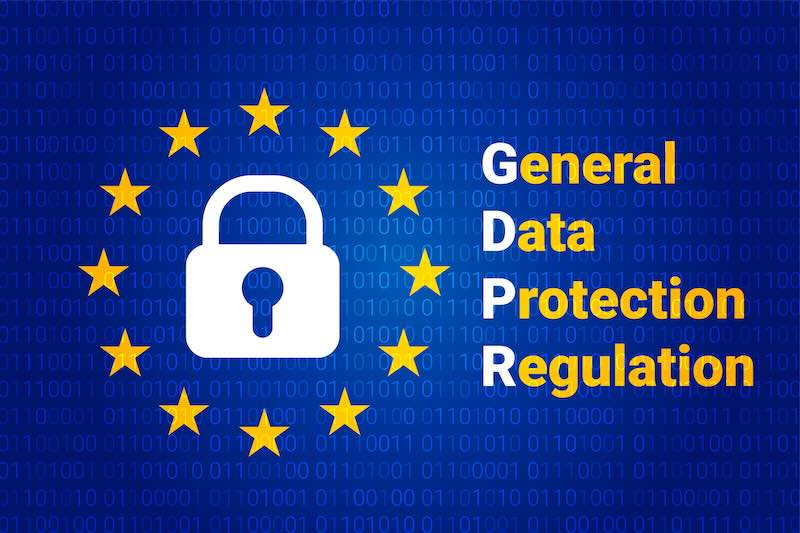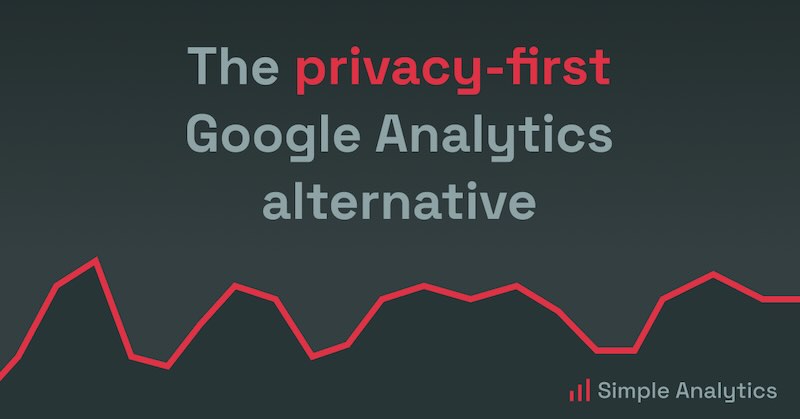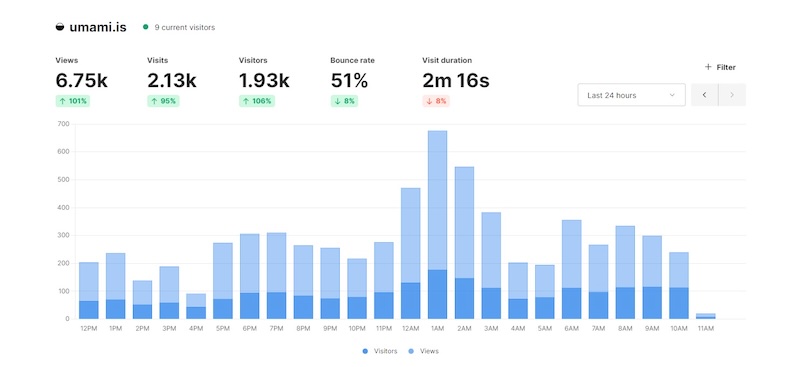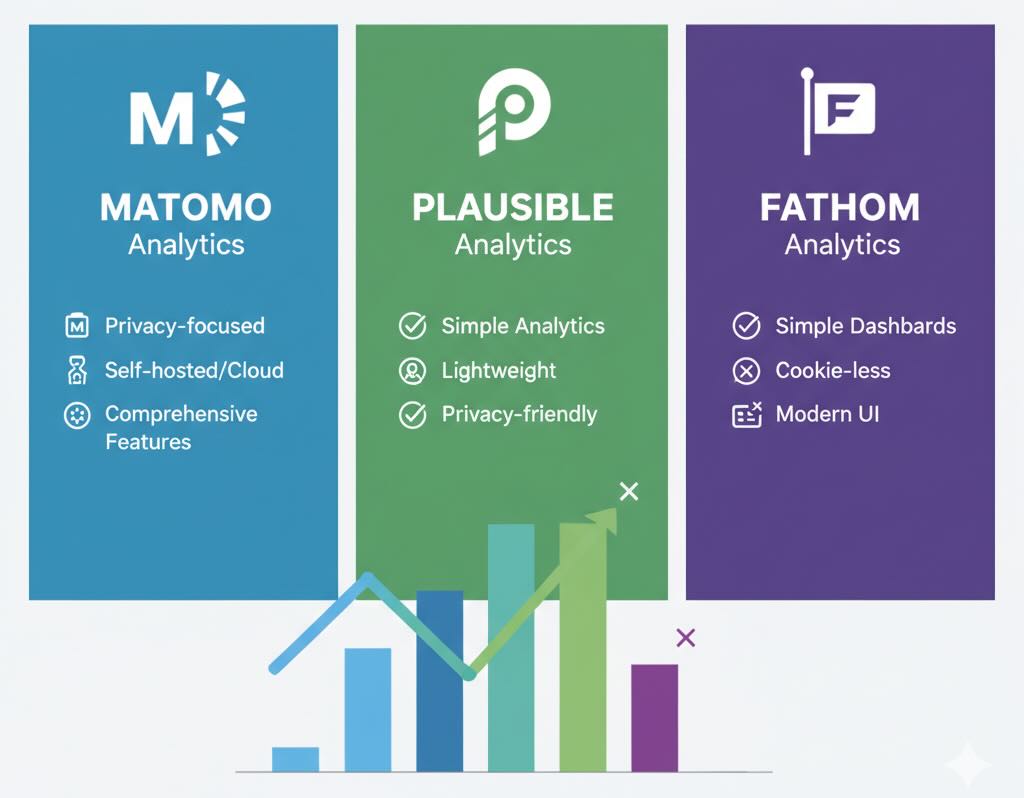All four privacy-first analytics platforms—Plausible, Fathom, Umami, and Simple Analytics—are designed to avoid adtech-style profiling and to minimize personal data. They take different routes to lawful processing, data residency, cookies, and enterprise paperwork (DPAs, SCCs). This guide explains how they approach GDPR principles in practice so marketers, product teams, and site owners can choose a tool that fits both their risk posture and reporting needs.
Important note: vendors update features and legal docs frequently. Treat this as a practical framework and verify specifics (DPA, SCCs, sub-processors, hosting regions, cookie banners) in each vendor’s current documentation before you commit.
What “privacy-first” actually means (in GDPR terms)

Before comparing tools, it helps to anchor on the core GDPR ideas that matter for web analytics:
- Lawful basis: Most privacy-first analytics operate on legitimate interests (Art. 6(1)(f)) when implemented in a cookie-less, low-identifiability way. If you set cookies or capture user-level identifiers, you’ll likely need consent.
- Data minimization & purpose limitation: Collect only what you need to measure content and conversions; avoid PII (emails, full IPs, device fingerprints).
- Storage limitation: Keep raw data for as short as possible and provide clear deletion/retention controls.
- Transparency: Provide a clear privacy policy, list sub-processors, and document where data is stored/processed (EU vs international transfers).
- Data subject rights: Honor requests for access/erasure/rectification—even if you don’t keep directly identifiable profiles.
- International transfers: If any processing involves non-EEA locations, you’ll need valid transfer mechanisms (e.g., SCCs or the EU-US Data Privacy Framework), depending on vendor architecture.
With that in mind, let’s see how each product turns these principles into product and policy choices.
Plausible: Cookie-less by default, clarity for content teams
Positioning: Lightweight, cookie-less analytics built for content and product teams that don’t want the compliance drag of adtech tracking.
site: https://plausible.io/

Key privacy traits
- Cookies & identifiers: Cookie-less by default. Uses aggregated, non-personally identifiable metrics. No cross-site profiling.
- IP handling: Typically IP addresses are not stored in full; implementations hash/truncate to reduce identifiability and resist re-identification.
- Lawful basis: Designed to support legitimate interests when used as shipped (no PII, no marketing cookies). If you extend tracking to user-level data or add cookies, you may need consent.
- EU hosting & data residency: Offers EU hosting and a privacy-sane data path (confirm exact regions/sub-processors in the current DPA).
- DPA & paperwork: Provides a Data Processing Addendum and sub-processor transparency; straightforward for SMBs and SaaS.
- Retention & deletion: Clear retention options; easy site-level deletion for right-to-erasure posture.
- Customer controls: Block/ignore specific IPs, use custom domains/proxying, and avoid third-party beacons.
Best fit: Teams wanting “cookie-less analytics with clean UI,” minimal banner complexity, and a clear path to legitimate interests.
Fathom: Executive-clean dashboards with strong data-sovereignty story
Positioning: Fast, simple analytics with multi-site focus; emphasizes EU privacy and no personal data profiling.
site: https://usefathom.com/

Key privacy traits
- Cookies & identifiers: Common implementation is cookie-less with aggregated reporting; not built for micro-profiling.
- IP handling: IPs are not stored in personally identifiable form; hashing and truncation reduce identifiability.
- Lawful basis: Usually legitimate interests for standard deployments; consent may be needed only if you introduce identifiers beyond the default.
- EU routing & transfer controls: Strong emphasis on EU and privacy-respecting infrastructure; check latest claims and SCCs/DPF in the DPA.
- DPA & paperwork: DPA available with clear roles (controller/processor) and list of sub-processors.
- Retention & deletion: Practical retention controls; straightforward data deletion at site level.
- Customer controls: Excellent multi-site administration, custom domains, and easy ignore rules help you minimize unnecessary data.
Best fit: Agencies and multi-brand operators needing clean overviews, fast load time, and a simple privacy story for non-technical stakeholders.
Simple Analytics: “Plain-English” privacy, friendly for owners & SMBs
Positioning: Human-readable dashboards and no-nonsense privacy; a strong option for non-technical owners who want to stay compliant.
site: https://www.simpleanalytics.com/

Key privacy traits
- Cookies & identifiers: Cookie-less by default; focuses on minimal, aggregated metrics.
- IP handling: Avoids storing full IP addresses; leans into data minimization across the stack.
- Lawful basis: Built to support legitimate interests under cookie-less usage; consent only if you introduce non-default identifiers.
- EU / regional options: Clear narrative around European hosting/data flows (verify current region options and sub-processors).
- DPA & paperwork: Offers DPA, transparent docs, and pragmatic guidance for small businesses.
- Retention & deletion: Intuitive retention settings; easy deletion to align with storage-limitation principles.
- Customer controls: Simple filters and privacy toggles; documentation is written for non-lawyers.
Best fit: SMBs and non-technical site owners who want to feel confident about privacy without reading a stack of legal footnotes.
Umami: Open-source control; privacy depends on your deployment
Positioning: Open-source analytics with a clean UI. You can self-host or use Umami Cloud for a managed experience.
site: https://umami.is/

Key privacy traits
- Cookies & identifiers: Default approach is cookie-less and aggregated. As self-hosted, you control how much you collect—powerful but requires discipline.
- IP handling: In Cloud or default self-host configs, expect truncation/hashing patterns; but you are the architect—avoid storing PII.
- Lawful basis: With minimal data and no cookies, legitimate interests can be justified; if you customize for user-level tracking/cookies, you’ll likely need consent.
- Data residency: Self-host wherever you need (EU-only if required). Cloud offers a curated environment—check regional options and sub-processors.
- DPA & paperwork: Umami Cloud provides the usual DPA scaffolding; self-host means you are the data controller and need to handle processor roles if you involve hosting providers.
- Retention & deletion: In self-host, you define retention policies. Cloud provides retention options aligned with privacy principles.
- Customer controls: Maximum flexibility (self-host), excellent for strict governance and sovereignty.
Best fit: Teams that want open-source control (self-host) or a managed experience (Cloud) while keeping analytics cookie-less and privacy-respecting.
Comparison table: GDPR and privacy posture at a glance
Scoring: Yes / Partial / Depends indicates practical realities; always verify vendor docs.
| Capability / Principle | Plausible | Fathom | Simple Analytics | Umami (Cloud / Self-host) |
|---|---|---|---|---|
| Cookie-less by default | Yes | Yes | Yes | Yes (both) |
| Full IP storage avoided | Yes (hash/truncate) | Yes (hash/truncate) | Yes (minimized) | Yes in Cloud; Depends self-host config |
| Lawful basis supported out-of-box | Legitimate interests | Legitimate interests | Legitimate interests | Legitimate interests (default patterns) |
| Consent needed for default use | Usually no | Usually no | Usually no | Usually no (Cloud); Depends self-host changes |
| EU hosting / data residency option | Yes | Yes | Yes | Cloud: Yes; Self-host: wherever you deploy |
| DPA available | Yes | Yes | Yes | Cloud: Yes; Self-host: you’re controller |
| SCCs / transfer mechanisms (if applicable) | Yes (verify latest) | Yes (verify latest) | Yes (verify latest) | Cloud: Yes (verify); Self-host: N/A if EU-only |
| Data retention controls | Yes | Yes | Yes | Cloud: Yes; Self-host: you configure |
| Right-to-erasure support | Yes (aggregate scope) | Yes | Yes | Cloud: Yes; Self-host: depends on design |
| PII safeguards / guidance | Strong docs | Strong docs | Very plain-English docs | Cloud: documented; Self-host: your policy |
| Multi-site governance | Good | Excellent | Good | Solid (esp. Cloud; self-host flexible) |
Choosing a tool by privacy scenario
- “We want analytics without cookie banners.”
Choose a cookie-less default that avoids personal data: Plausible, Fathom, Simple Analytics, or Umami in default form. Confirm with counsel that your specific implementation fits legitimate interests (e.g., no extra identifiers or marketing cookies). - “We need EU-only processing and strict sovereignty.”
- Umami self-host in the EU (you own infra and data paths).
- Or EU-hosted plans from Plausible/Fathom/Simple Analytics (verify sub-processors, logs, and failover regions).
- “We’re an agency—many domains, quick reporting, minimal legal friction.”
- Fathom for the fastest multi-site overview and straightforward privacy posture.
- Plausible if clients want slightly deeper content/campaign breakdowns but still cookie-less.
- “We’re SMB owners—we just want clear privacy and clear charts.”
- Simple Analytics: friendliest language, strong cookie-less defaults, easy paperwork.
Practical compliance checklist for any of the four
- Keep it cookie-less. Don’t introduce extra identifiers unless there’s a clear legal basis (and then use consent).
- No PII in events. Never send emails, full IPs, addresses, or IDs to your analytics.
- Use EU hosting if you need it. Or self-host Umami in the EU.
- Sign the DPA. Make sure your role (controller/processor) is reflected correctly.
- Document your lawful basis. Add it to your privacy policy, name your analytics provider, and link to their docs.
- Set retention. Shorter is better—align with storage limitation principles.
- Honor rights requests. Even with aggregate data, describe how you satisfy access/erasure at policy level.
- Review sub-processors annually. Vendors add or change providers; keep your records current.
Buyer’s guide: picking the right privacy posture
- Minimal banners, minimal friction: Pick a cookie-less default (all four do this) and verify your counsel is comfortable with legitimate interests for your exact use.
- European-only compliance: Prefer EU hosting or self-host Umami in the EU, document sub-processors, and keep a transfer assessment on file if anything touches non-EEA.
- Enterprise checks: Make sure the vendor offers DPA, SCCs, and visible sub-processor lists; confirm incident response timelines and contact methods for data subject requests.
- Future-proofing: The no-cookie, minimal data approach is the most resilient against evolving browser restrictions and consent fatigue.
Final word
You don’t need to trade insight for privacy. Plausible, Fathom, Simple Analytics, and Umami prove that analytics can be fast, useful, and respectful of user rights. Your best choice depends less on raw “features” and more on how you operate: number of sites, who reads reports, where you can host, and how much control you want.
Pick the tool that matches your privacy stance and your day-to-day workflow. Then lock in cookie-less defaults, short retention, and a clear privacy policy—and enjoy analytics that stakeholders trust.

